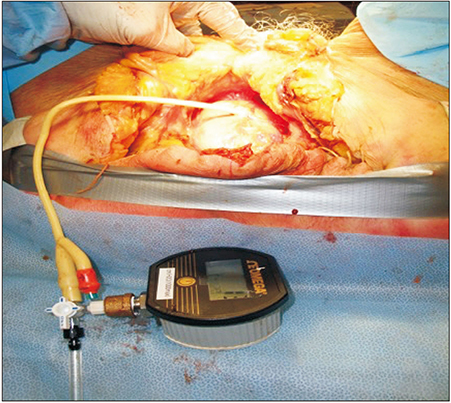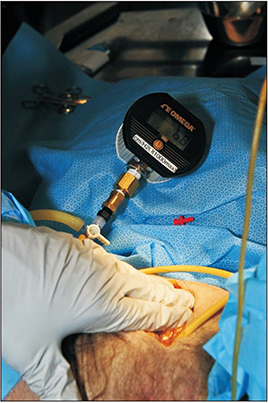Investig Clin Urol.
2019 Sep;60(5):367-372. 10.4111/icu.2019.60.5.367.
A novel human cadaver model to investigate a retrourethral transobturator male sling procedure
- Affiliations
-
- 1Westmead Private Physiotherapy Services, Westmead Private Hospital Sydney, Sydney, Australia.
- 2The Clinical Research Institute, Sydney, Australia.
- 3Department of Health Professions, Faculty of Health, Arts and Design, Swinburne University of Technology, Melbourne, Australia.
- 4Division of Urology, Department of Surgery, University of Pennsylvania Health System, Philadelphia, PA, USA.
- 5Centre for Economic Impacts of Genomic Medicine (GenIMPACT), Macquarie University, Sydney, Australia.
- 6Department of Urology, Westmead Hospital, Sydney, Australia.
- 7Discipline of Surgery, Sydney Medical School, The University of Sydney, Sydney, Australia.
- 8Urology Service, Department of Surgery, Memorial Sloan-Kettering Cancer Center, New York, NY, USA. sandhuj@mskcc.org
- KMID: 2455964
- DOI: http://doi.org/10.4111/icu.2019.60.5.367
Abstract
- PURPOSE
To develop a cadaver model for the assessment of a male transobturator male sling (retrourethral transobturator sling [RTS], AdVanceâ„¢; Boston Scientific, USA) to investigate its effect on a simulated abdominal and retrograde leak point pressures (ALPP, RLPP) and the urethral pressure profile (UPP).
MATERIALS AND METHODS
Three fresh frozen human male cadaver specimens were obtained. A suprapubic tube was inserted into the bladder and connected to a digital manometer to measure bladder pressure. Manual suprapubic pressure was then applied to generate an increase in intraabdominal pressure and measure a simulated ALPP. Subsequent measurements of RLPP and UPP were recorded. All measurements were undertaken prior to and following insertion of a RTS.
RESULTS
The placement of the RTS consistently increased the simulated ALPP for all three cadaver specimens when compared to baseline measures. No leaks occurred at simulated ALPP's of 170 cm H2O for specimen 1, 160 cm H2O for specimen 2, and 170 cm H2O for specimen 3. There was minimal or no change in the RLPP's and UPP's following insertion of the RTS when compared to respective baseline.
CONCLUSIONS
A model using fresh unfixed cadavers that incorporates a simulated measurement of ALPP is feasible for male stress urinary incontinence surgical intervention investigations.
Keyword
Figure
Reference
-
1. Sanda MG, Dunn RL, Michalski J, Sandler HM, Northouse L, Hembroff L, et al. Quality of life and satisfaction with outcome among prostate-cancer survivors. N Engl J Med. 2008; 358:1250–1261.
Article2. Dahl S, Cvancarova M, Dahl AA, Fosså SD. Work ability in prostate cancer survivors after radical prostatectomy. Scand J Urol. 2016; 50:116–122.
Article3. He W, Goodkind D, Kowal P. U.S. Census Bureau. International population reports, P95/16-1, An aging world: 2015. Washington, DC: U.S. Government Publishing Office;2016.4. Groutz A, Blaivas JG, Chaikin DC, Weiss JP, Verhaaren M. The pathophysiology of post-radical prostatectomy incontinence: a clinical and video urodynamic study. J Urol. 2000; 163:1767–1770.
Article5. Comiter CV. Male incontinence surgery in the 21st century: past, present, and future. Curr Opin Urol. 2010; 20:302–308.
Article6. Kowalik CG, DeLong JM, Mourtzinos AP. The advance transobturator male sling for post-prostatectomy incontinence: subjective and objective outcomes with 3 years follow up. Neurourol Urodyn. 2015; 34:251–254.
Article7. Rehder P, Haab F, Cornu JN, Gozzi C, Bauer RM. Treatment of postprostatectomy male urinary incontinence with the transobturator retroluminal repositioning sling suspension: 3-year follow-up. Eur Urol. 2012; 62:140–145.
Article8. Rehder P, Gozzi C. Transobturator sling suspension for male urinary incontinence including post-radical prostatectomy. Eur Urol. 2007; 52:860–866.
Article9. Healy SE, Rai BP, Biyani CS, Eisma R, Soames RW, Nabi G. Thiel embalming method for cadaver preservation: a review of new training model for urologic skills training. Urology. 2015; 85:499–504.
Article10. Rashid P, Gianduzzo TR. Urology technical and non-technical skills development: the emerging role of simulation. BJU Int. 2016; 117 Suppl 4:9–16.
Article11. Oliphant S, Littleton EB, Gosman G, Sutkin G. Teaching the retropubic midurethral sling using a novel cadaver and model-based approach. Cureus. 2017; 9:e1214.
Article12. Comiter CV, Sullivan MP, Yalla SV. Retrograde leak point pressure for evaluating postradical prostatectomy incontinence. Urology. 1997; 49:231–236.
Article13. Brown M, Wickham JE. The urethral pressure profile. Br J Urol. 1969; 41:211–217.
Article14. Comiter CV, Rhee EY. The ‘ventral urethral elevation plus’ sling: a novel approach to treating stress urinary incontinence in men. BJU Int. 2008; 101:187–191.
Article15. Hogewoning CR, Elzevier HW, Pelger RC, Bekker MD, DeRuiter MC. Risk of damage to the somatic innervation of the penis during the AdVanceProcedure: an anatomical study. J Sex Med. 2015; 12:1705–1710.16. Davies TO, Bepple JL, McCammon KA. Urodynamic changes and initial results of the AdVance male sling. Urology. 2009; 74:354–357.
Article17. McGuire EJ, Cespedes RD, O'Connell HE. Leak-point pressures. Urol Clin North Am. 1996; 23:253–262.
Article18. D'Ancona C, Haylen B, Oelke M, Abranches-Monteiro L, Arnold E, Goldman H, et al. The International Continence Society (ICS) report on the terminology for adult male lower urinary tract and pelvic floor symptoms and dysfunction. Neurourol Urodyn. 2019; 38:433–477.19. Raz O, Tse V, Chan L. Urodynamic testing: physiological background, setting-up, calibration and artefacts. BJU Int. 2014; 114 Suppl 1:22–28.
Article20. Rehder P, Mitterberger MJ, Pichler R, Kerschbaumer A, Glodny B. The 1 year outcome of the transobturator retroluminal repositioning sling in the treatment of male stress urinary incontinence. BJU Int. 2010; 106:1668–1672.
Article21. Soljanik I, Becker AJ, Stief CG, Gozzi C, Bauer RM. Urodynamic parameters after retrourethral transobturator male sling and their influence on outcome. Urology. 2011; 78:708–712.
Article22. Ullrich NF, Comiter CV. The male sling for stress urinary incontinence: urodynamic and subjective assessment. J Urol. 2004; 172:204–206.
Article23. Rehder P, Staudacher NM, Schachtner J, Berger ME, Schillfahrt F, Hauser V, et al. Hypothesis that urethral bulb (Corpus Spongiosum) plays an active role in male urinary continence. Adv Urol. 2016; 2016:6054730.
Article24. Pistolesi D, Zampa V, Gozzi C, Mariani C, Santarsieri M, Faggioni L, et al. Could the sling position influence the clinical outcome in male patients treated for urinary incontinence? A magnetic resonance imaging study with a 3 tesla system. Urology. 2014; 83:471–476.
Article25. Comiter CV, Nitti V, Elliot C, Rhee E. A new quadratic sling for male stress incontinence: retrograde leak point pressure as a measure of urethral resistance. J Urol. 2012; 187:563–568.
Article26. Bamshad BR, Hadley HR, Ruckle HC, Lui PD. Perfusion sphincterometry for objective evaluation of postprostatectomy intrinsic sphincter deficiency. Urology. 1999; 53:968–973.
Article27. De Ridder D, Rehder P. The AdVance® male sling: anatomic features in relation to mode of action. Eur Urol Suppl. 2011; 10:383–389.
Article28. McCammon K, Haab F. AdVance® male sling: surgical technique and postoperative patient management. Eur Urol Suppl. 2011; 10:395–400.
Article29. Barnard J, van Rij S, Westenberg AM. A Valsalva leak-point pressure of >100 cmH2O is associated with greater success in AdVance™ sling placement for the treatment of post-prostatectomy urinary incontinence. BJU Int. 2014; 114 Suppl 1:34–37.30. Rassweiler J, Teber D, Kuntz R, Hofmann R. Complications of transurethral resection of the prostate (TURP)--incidence, management, and prevention. Eur Urol. 2006; 50:969–979. discussion 980.
Article
- Full Text Links
- Actions
-
Cited
- CITED
-
- Close
- Share
- Similar articles
-
- The Comparision of the Short Term Result of Transobturator and Retropubic Mid Urethral Slings in the Female Stress Urinary Incontinence
- Pelvic Hematoma following a Transobturator Vaginal Tape Surgery for Treating Stress Urinary Incontinence
- Proper Mesh Placement Using the Outer Cylinder of a Ballpoint Pen in the Transobturator Adjustable Tape Sling Procedure for Female Stress Urinary Incontinence
- The Formation of Abscesses in the Peritoneal Cavity and the Left Internal Obturator Muscle as the Complications of the Transobturator Tape Procedure
- The artificial urinary sphincter and male sling for postprostatectomy incontinence: Which patient should get which procedure?



